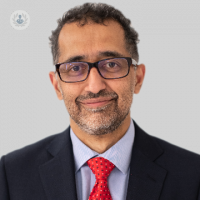Aortic stenosis: what is it and how does it occur?
Written by:Unfortunately, the health of our heart cannot always remain in prime condition, especially as we get older. As we age, the aortic valve, which is located in our heart, slowly begins to narrow, leading to a common valve condition referred to as aortic stenosis.
In our latest article, we spoke to exceptionally well-regarded cardiologist, Dr Iqbal Malik, with regards to the common valve disease condition. Here, the London-based doctor provides a detailed insight into aortic stenosis, describing why it occurs and outlining effective treatment options for the heart-related problem.

Aortic stenosis: what is it and how does it occur?
There are four valves in the heart and the most important ones are located on the left-hand side, which is the high-pressure part of the circulation. There is an inflow valve (the mitral valve), which could potentially narrow or leak. There is also an outflow valve (the aortic valve), which can also narrow or leak.
Recent innovations in medicine have focused on the aortic valve and especially the narrowing that can occur as one gets older. This process is called aortic stenosis. If you have aortic stenosis, it can sit there minding its own business, slowly narrowing with no symptoms being experienced at all.
However, problems arise as soon as the aortic valve starts to develop a more severe narrowing, such as breathlessness, chest pain, dizziness which leads to blackouts. These are all danger signals that the aortic valve needs to be fixed.
What is the most effective treatment for aortic stenosis?
Typically (in adult patients) a definitive operation is required to effectively treat aortic stenosis. It could be performed in a minimally invasive manner (vis a small cut on the side of the chest, but still using a heart lung bypass machine, or through a standard cut in the middle of the chest- a median sternotomy. Either way, the surgeon removes the old valve and sutures the new valve into position.

What age groups are most suited to new minimally invasive treatments (TAVR)?
Nowadays, a revolutionary aortic stenosis treatment such as transcatheter aortic valve replacement (TAVR) can be performed on those in their 70s, and we occasionally also perform this particular procedure on people in the 60s. Why can TAVR not be performed on all patients of all age groups? We do not typically perform TAVR on all age groups due to the fact that it is a tissue aortic valve. Tissue valves do not last 20 years even when they are surgically put in. They typically last 10-15 years.
Therefore, if you are 30, you may well need to have many more operations if we keep putting in tissue valves. For this reason, we tend to opt to place metal or mechanical valves into the younger patients. With these valves, unlike tissue valves, you need warfarin therapy to keep the valve from clotting.
Prior to the invention of TAVR, a mechanical valve would be used even in patients in their 60s with one main aim in mind: to try to achieve 20 years without a redo operation for them. Now, when you are in your 50s and 60s, the surgeon may well put in a tissue valve, which will typically degenerate after a decade. We could place a TAVR inside that when it fails, saving a redo operation. When you are in your 70s, especially if surgery is considered high risk, it is very reasonable to consider a TAVR procedure as first-line therapy.
What is TAVR?
Using a catheter from the femoral artery (at the top of your leg), a valve that is compressed inside the catheter can be advanced into position and expanded against the old chalky aortic valve. The chalk holds the new valve in position without sutures, and because there are no cuts on the chest, it is performed without general anaesthetic. If all has gone well, the patient may even go home the same day.
If you have any concerns regarding the health of your heart or are considering undergoing a minimally invasive procedure to treat this common valve disease, you can book an appointment and check Dr Malik's availability by visiting his Top Doctor's profile.


